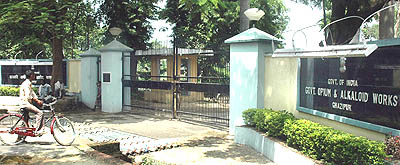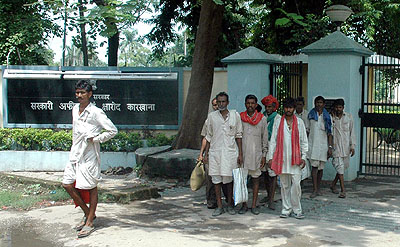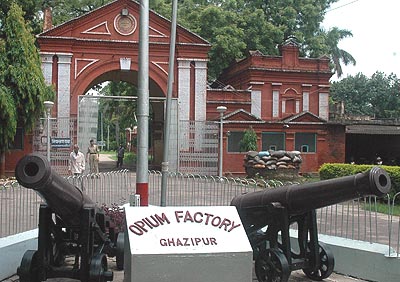 Until celebrated novelist Amitav Ghosh wrote it in his latest work of fiction, though liberally laced with history and sociology, Sea of Poppies---we, like him, too were quite unaware of the fact that it was Ghazipur opium factory which had financed British Raj in India as the single largest opium producers in the world, and more startlingly it continues to be the so.
Until celebrated novelist Amitav Ghosh wrote it in his latest work of fiction, though liberally laced with history and sociology, Sea of Poppies---we, like him, too were quite unaware of the fact that it was Ghazipur opium factory which had financed British Raj in India as the single largest opium producers in the world, and more startlingly it continues to be the so.
Digging deep into the quirky footnotes of Ghosh's novel contexts I decided to make a visit to the world's largest legitimate opium factory to gather more on it for its discerning readers. It was unwaveringly an eye-opener to get the facts on the factory and be not surprised.
The opium factory of Ghazipur in Ghosh's novel now has become The Govt. Opium and Alkaloid Works and its one of the very few government enterprises with so much of a load of history, is running in absolute profit since its establishment in 1820. Spread across 52 acres on the banks of holy Ganga the factory now has a workforce of about 900 staffs.
 This central government undertaking factory now runs under the ministry of Finance, department of Revenue. The overall management of the factory is rested with the committee of management under the chairmanship of the Additional secretary, Revenue, ministry of Finance of the government of India.
This central government undertaking factory now runs under the ministry of Finance, department of Revenue. The overall management of the factory is rested with the committee of management under the chairmanship of the Additional secretary, Revenue, ministry of Finance of the government of India.
The factory and its functions, though, are governed in accordance with the provisions contained in the Narcotics Drugs and Psychotropic Substance Act and Rules, 1985. Headed by a Chief Controller who sits in its headquarter office of Gwalior and Delhi the General Manager is in charge of the factory affairs at Ghazipur.
 The age-old opium factory runs in two shifts whereas its later addition Alkaloid workshop runs from 8:30 in the morning to 4:30 in the evening. Established in 1820 by East India Company the Opium factory, surprisingly got its first moderation plan just two years back and the obsolete method of drying the raw opium manually by workers is now being done through machines.
The age-old opium factory runs in two shifts whereas its later addition Alkaloid workshop runs from 8:30 in the morning to 4:30 in the evening. Established in 1820 by East India Company the Opium factory, surprisingly got its first moderation plan just two years back and the obsolete method of drying the raw opium manually by workers is now being done through machines.
For well over 120 years the factory was only processing opium extracts from raw stuffs to export it to China by the British empire to get tea and silk in trade. However, during the Second World War when the soldiers needed life-saving drugs like morphine, an Alkaloid factory was set up in the campus in 1943.
Now the Alkaloid unit of the factory is engaged in processing raw opium into alkaloids of Pharmacopoeia grades to meet the domestic demands of all the major pharmaceutical companies of the country. With altogether 50 chemists in the Alkaloid unit of the factory manufactures about 14 products to be used in pharmaceutical compositions.
Products like Codeine phosphate, Codeine Sulphate, Morphine salts, Dionine IP, Nacopine B.P., morphine BPC, Morphine Hydrochloride, Thebaine Pure, IMO Powder, IMP cake, Cotarmine Chloride etc are being manufactured and supplied to pharmaceutical companies under strict guidance and observations.
However, interestingly, this Alkaloid unit of the factory is running in loss whereas the opium factory still making huge profit every year. "On an average there is a Rs 7 crore loss from Alkaloid unit whereas the opium factory we make profit of Rs 15 crore each year", said Manik Mukharejee, the chief accounts manager and financial advisor of the factory.
However, the total turnover of the factory comes around Rs 200 crore, says Mukherjee.
The Opium factory runs in profit because of its export value. "We export Opium to countries like USA, Japan, France and Sri Lanka. Currently USA and Japan are major importers of opium but earlier it was united Russia", said sales manager R C Srivastava. This year order from USA alone is around 360 ton of Opium, said further.
According to factory officials the cultivation of Opium poppy [ Papaver Somnigerum] has declined sharply in Uttar Pradesh but it still being grown by farmers of Rajasthan [Kota and Bhilwara] and Madhya Pradesh [Neemuch and Mandsaur].
Earlier, the major poppy cultivating areas in UP were Bareilly, Barabanki, Faizabad and Shahjahanpur where every year the India government officials have been visiting to notify the areas and the quantity to those farmers who expressed their desire for the poppy cultivation.
The Ghazipur opium factory is the place where even the contraband opium seized by the police personnel are stored and there is a separate unit for such seized stuffs, said the factory officials. "But, these seized opium's could only be sent here once the case was over and moreover they donot have high contents of morphine also", they said.
Ghazipur, on the bank of river Ganga is a small town in eastern part of Uttar Pradesh with rich historical background. It was named after Saiyyed Masood Ghazi of Tughlaq dynasty in 1330 AD and since then its been a center of trade in eastern part of the country.
It was because of its strategic location from sea transportation the Britishers in 1764 AD brought it under their suzerainty and thereafter the East India Company with Robert Waterloo as its first district collector. However, during the last years of Mughal empire the state had lost its control over Opium trade and it was now held by a ring of merchants in Patna.
But in 1757 the monopoly of Poppy cultivation had passed into the hands of East India Company and the Company later started its trade in Opium, Indigo, Kewra and Floriculture, especially Roses. They stared sending Opium to Calcutta port by river transportation from Ghazipur and from there it was exported to China.
Besides, Opium, Ghazipur till recent time was also famous for its perfume industry, especially Rose water and Itr[otto of Roses] and handloom weaving but with the passage of time these industry died its premature death leaving the Opium factory as the only landmark for the district.
Today Ghazipur is either known for its Opium factory or its criminal face. According to police records Ghazipur is one of the most notoriously crime infested district of Uttar Pradesh with some of the big names of underworld.
Though, it's a different matter that the first scientific society of India was established in Ghazipur in 1862 by Sir Syyed Ahmed Khan for propagating modern western knowledge of science, technology and industry. Some of the luminaries from the district include the present Vice-President Hamid Ansari, noted sitar maestro Pd. Ravi Shankar and celebrated writer Rahi Masoom Raza.
An another landmark historical pause of Ghazipur is that the British Governor General who had pioneered land reforms in India Lord Cornwallis at the age of 67 had died in this town on October 5' 1805 and there is a 12 pillars 3.66 meter height beautiful tomb in his memory here, sculptured by Flaxman, R.A. from London.
History says that Lord Cornwallis who had first governed India from 1786-1793 was again invited for the job in 1805 and he died accidentally in Ghazipur.
However, inside the Opium factory not much has changed what Ghosh had described in detail in his critically acclaimed novel. The factory still carries the colonial legacy with its redbrick, thick walled structures standing in horizontal harmony. There is a unique shaped water tank with a canopy like cover marked with water level marks and surprisingly its still been the water storage tank for the factory.
There is another solar watch installed inside the campus made by an opium agent H.M.R.H. Hopkins Esor in 1911-1913. The solar watch bears the unique testimony of Opium trade from the factory.
Inside the Opium factory there is rows of barrack-like structures behind high walls topped with barbed wires. Workers ripping with briny sweats could be seen carrying colorful plastics buckets full of opium to pour into the long crates placed outside for drying the stuffs. Each plastic buckets carries 35 kg of opium there was ten rows of crates each containing 10 tons of raw opium for its drying process.
Later, once it reached the 90% moisture free the workers take them inside the huge storage and there they cut them into 5 kgs cake shape top pack in a 60 kg box to export. From here, the neatly packed, under the specified instructions, the Opium reaches to the railway station under strict security supervision and from there t goes either to Mumbai or New Delhi for exporting to foreign shores.
Earlier, there were three kinds of Opium were made in Ghazipur factory: The Provision Opium, the Excise Opium and Medical Opium but now they make it four types in accordance with its purity value. With its 12% morphine content the Indian licit Opium is being considered as the purest form of Opium in the world and so its huge demand from foreign countries.
There is a full-proof security arrangement by the Central Industrial Security Force [CISF] personnel to check any pilferage of Opium or its by products from the factory. Altogether 123 CISF personnel are stationed for security check inside the factory and the secuirtymen even did not allow Agenda team to take camera inside the factory.
 Though, after much persuasion and cajoling they allowed us to take the pictures of the factory from outside.
Though, after much persuasion and cajoling they allowed us to take the pictures of the factory from outside.
Novelist Amitav Ghosh while making reference to his enormous research for the novel said that Opium trade infact accounted for 17-20% of Indian revenues during British period which continued even till 1920s. "If you think in those terms one single commodity accounted for such an enormous part of your economy is unbelievable, extraordinary", said he in an interview.
The Opium exporting to China which was started with Warren Hastings, the first Governor General of India in 1780 later led to the famous Opium War [1839-1842] of modern world history.
"Then the situation was similar of today. There was a huge balance of payments problem in relation to China and China was exporting enormous amounts, but wasn't interested in importing any European goods. That was when Hastings came up with idea that the only way of balancing trade was to export opium to China", explained Amitav Ghosh in one of his countless interviews.
The 'addictive' novel of Ghosh also throws light on British appetite for tea and so the satisfy their appetite the East India Company virtually wrecked havoc in the Gangetic plains of Eastern India compelling peasants to grow Opium which later went on to devastate China. However, the trade yielded the Company about two millions of pound yearly which eventually financed the British Raj in India.
And, the British legacy of Opium continued with an another similar factory set up in 1935 at Neemuch in Madhya Pradesh. The Neemuch factory, though, is a modern one but the Ghazipur still is the biggest and largest not only in Asia but the world making profit for the organization and filling foreign reservoir of the country.
The sprawling campus of the factory has its own four-bed hospital, modern guesthouse and the staff quarters. It has also an R&D section and the Alkaloid unit which are the modern monumental additions. The Factory has its own water tank and a power system that makes it segregated from the power-and-water starved areas of the district.
Inside the huge campus there is a temple of Baba Shayamdas and a mazaar of a saint and both are said to exist there much before the Opium factory established at the place.
The entire factory is infested with snakes and populated with moneys and believe it or not, the monkeys of Ghazipur have become the latest victim of this British legacy of Opium.
Inside, the drying zone of Opium platoons of monkey with red back could be seen roaming around lazily in search of an opium piece or scrubs. Despite all our best efforts they donot leave the place and "seemingly have become addicted of Opium".
"Most of the time we have to drag the dozing, addictive monkeys from the place by holding their tails", said the workers.
Ghosh might take a cue from this monkey-business of Opium for his second part of the trilogy.